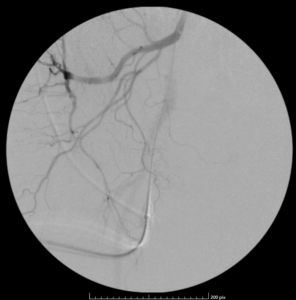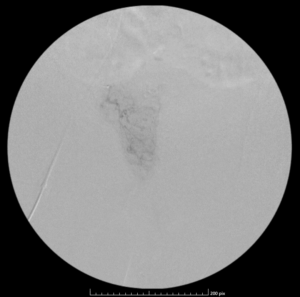How is prostate artery embolization performed?
The Prostate artery embolization (PAE) procedure is one of the newest minimally invasive treatments for an enlarged prostate gland, also known as benign prostatic hyperplasia or BPH. Because it is an endovascular procedure, meaning performed entirely inside of the blood vessels, it is more technical than most of the other options for treating BPH. Therefore, one of the most common questions patients ask is, “How is prostate artery embolization performed?”
Pelvis angiography

The first part of prostate artery embolization is an X-ray dye study to identify the blood supply of a prostate gland. The general term for this is an angiogram. In this case, we perform an angiogram of each half of the pelvis to look for the origin of the prostate arteries. Contrast dye is injected through a small tube inserted through the femoral artery, which is the main artery in the groin. Getting clear imaging to identify the prostate arteries is very important to ultimately achieve an effective embolization of the entire gland. To optimize the imaging, we have a nurse anesthetist provide deep sedation, just like during a colonoscopy. That ensures our patients are comfortable and still through the critical parts of the procedure.

Prostate angiography
Once the prostate blood supply is identified, our interventional radiologist will direct a very small tube about the size of a thin pasta noodle into the prostatic artery. This is called a microcatheter. Another angiogram from the prostate artery will be performed to confirm that this artery is indeed supplying the prostate gland and to identify any other arteries connected to nearby organs that we do not want to embolize.
Prostate artery embolization
When our microcatheter is in position, we will begin the prostate artery embolization. This is the therapeutic part of the procedure. A vial of FDA-approved soft plastic beads, usually 0.3 – 0.5 mm in size, is slowly injected into the prostate artery until the blood flow comes to a halt. We visualize this by mixing the beads with contrast dye. Once we are finished with one side, we repeat the same process on the other side.
Our Austin interventional radiologist provides cutting-edge prostate treatment
If you are looking into treatment options for your enlarged prostate gland and would like to speak with our interventional radiologist in Austin, Texas, please contact us. We have treated hundreds of patients and have the minimally invasive skills to treat your enlarged prostate gland.
